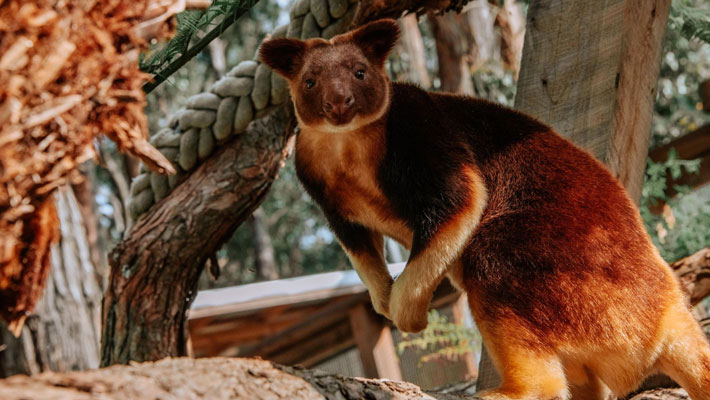A Second Home
From kangaroos to echidnas, possums to cassowaries, many of Australia’s most iconic animals are found natively on the island of New Guinea. Australia and New Guinea share a strong similarity in fauna due to the land bridges that once connected the islands, allowing animals to cross between. Some animal species are found on both islands, whilst others like Goodfellow’s tree kangaroo are closely related but unique to New Guinea.
From the Trees and Back Again
The ancestors of modern kangaroos were tree-dwellers who traded their arboreal lifestyle for the ground, using energy-efficient hops to transverse great distances. Some of these early kangaroos returned to the trees in search for food, losing their skilful hops in favour of legs adapted to climbing. With smaller hindlimbs than their ground-dwelling cousins, these tree kangaroos have readapted to life in trees, but now have slow, clumsy hops when on the ground.
The Threats they Face
There are fourteen species of tree-kangaroos found throughout the tropical forests and rainforests of far-north Queensland and New Guinea, which have all faced threats due to habitat loss and hunting. For Australia’s two tree-kangaroo species, an end to traditional hunting and protection of their habitat as part of a World Heritage Area has allowed their populations to stabilise. Ongoing deforestation and hunting in New Guinea continue to push the island’s 12 tree kangaroo species towards extinction. Better protection of habitat and hunting restrictions are essential to protecting these unique species.
Ending the Extinction
Goodfellow’s tree kangaroo is one of two New Guinea tree kangaroo species with an international breeding program, which are raising awareness and providing insurance against extinction. Much of the deforestation occurring throughout their habitat in Indonesia and Papua New Guinea is for international supply including timber and palm oil. You can help reduce deforestation by buying certified sustainable FSC wood and paper products and RSPO Palm Oil. Visit Nura Diya Australia and the Tiger Trek at Taronga to learn more about how you can help end bring an end to deforestation.
One at a time
Compared to other macropods, tree kangaroos are the only ones that are able to move their hind limbs independently while walking, instead of moving them in the typical synchronous manner (together).
Snooze time
Despite spending about 60% of their time sleeping, Tree Kangaroos don’t build nests for slumber. They just sleep on whatever branch they feel safe in!

Come and meet us
Meet our Goodfellow’s Tree Kangaroos in our brand-new Australian Habitat Nura Diya Australia at Taronga Zoo Sydney.